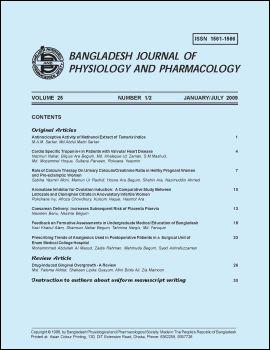Drug-Induced Gingival Overgrowth - A Review
DOI:
https://doi.org/10.3329/bjpp.v25i1.5743Keywords:
Gingival overgrowthAbstract
Drug-induced gingival overgrowth is a side effect associated with 3 types of drugs: anticonvulsants (phenytoin), immunosuppressive agents (cyclosporine A), and various calcium channel blockers for cardiovascular diseases. Gingival overgrowth is characterized by the accumulation of extracellular matrix in gingival connective tissues, particularly collagenous components with various degrees of inflammation. Although the mechanisms of these disorders have not been elucidated, recent studies suggest that these disorders seem to be induced by the disruption of homeostasis of collagen synthesis and degradation in gingival connective tissue, predominantly through the inhibition of collagen phagocytosis of gingival fibroblasts. In this review, we focus on collagen metabolism in drug-induced gingival overgrowth, focusing on the regulation of collagen phagocytosis in fibroblasts.DOI: 10.3329/bjpp.v25i1.5743
Bangladesh J Physiol Pharmacol 2009; 25(1&2) : 26-29
Downloads
Download data is not yet available.
Abstract
263
263
PDF
178
178
Downloads
How to Cite
Akhter, M. F., Quayum, S. L., Ali, A. B., & Mamoon, Z. (2010). Drug-Induced Gingival Overgrowth - A Review. Bangladesh Journal of Physiology and Pharmacology, 25(1), 26–29. https://doi.org/10.3329/bjpp.v25i1.5743
Issue
Section
Review Articles

